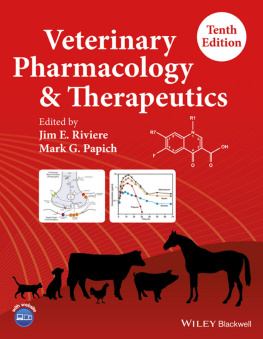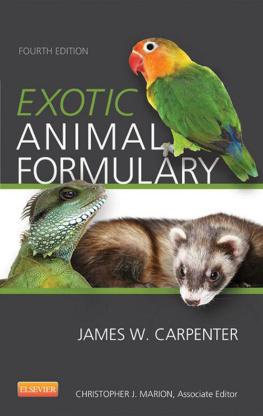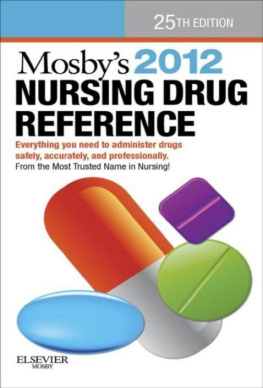Plumbs
Veterinary Drug
Handbook
7th Edition
Donald C. Plumb, Pharm.D.
COPYRIGHT 2011 by Donald C. Plumb
All rights reserved. No part of this book may be reproduced or transmitted in any form or any means, electronic or mechanical, including recording, photocopying, or by any information storage and retrieval system, without the written permission of the copyright owner.
PUBLISHED BY
PharmaVet Inc.
Stockholm, Wisconsin
www.vetdruginfo.com
DESIGN AND TYPESETTING
Judy Gilats
Peregrine Graphics Services
St. Paul, Minnesota
ISBN: 978-0-4709-5965-7
Ebook ISBN: 978-0-9834-1810-8
2011 1
For Maia and Nathanial
* * *
Consulting Editor
Gigi Davidson, DICVP
North Carolina State University Raleigh, NC
Ophthalmology Products, Topical
Principles of Compounding Ophthalmic Products
Contributors to this Edition
Camille DeClementi, VMD, DABT
ASPCA Animal Poison Control Center Urbana, IL
Overdose and Toxin Exposure Decontamination Guidelines, ASPCA Animal Poison Control Center Data for Drug Monographs
Dinah Jordan, PharmD, DICVP
Mississippi State University
Mississippi State, MS
Insulin Monograph
Sandra Koch, DVM, MS, DACVD
College of Veterinary Medicine,
University of Minnesota St. Paul, MN
Dermatological Agents, Topical Otic Agents
Justine Lee, DVM, DACVECC
Pet Poison Helpline/SafetyCall International Bloomington, MN
Fat Emulsion, Intravenous Monograph
Sheila Torres, DVM, MS, PhD, DACVD
College of Veterinary Medicine, University of Minnesota
St. Paul, MN
Dermatological Agents, Topical Otic Agents
With Appreciation
Id like to give a special thank you to my wife, Shirley, who spent countless hours assisting with the preparation of this reference and perhaps most importantly, kept me sane (mostly) during the long process of writing and updating the work.

To sign up for e-mail notification of updates and errata , or get information on ordering information for additional versions, visit Plumbs Veterinary Drug Handbooks website at: www.vetdruginfo.com

Preface to the Seventh Edition
In this edition, Plumbs Veterinary Drug Handbook continues with its mission to serve as a single volume reference to assist veterinarians, other health professionals, and animal caretakers in providing optimal drug therapy for veterinary patients. In addition to updating all the monographs, 20+ new systemic drug full monographs (see below) and several new ophthalmic and topical dermatologic drug monographs have been added. Additional information on compounding dosage forms has been added to many monographs.
Several monographs have been retired in this edition, primarily due to their withdrawal from the marketplace and/or being replaced in therapy with newer, ostensibly better, drug compounds. Two sections have been removed from the appendix. After consulting with several veterinary oncologists, I decided that listing chemotherapy drug protocols was not in the best interest of patient care. They change often and the drugs used have enough inherent safety issues that I believe chemo use in private practices must be carefully considered, in collaboration with oncologists and oncology-specific resources. The therapeutic diet tables have also been removed, again because they rapidly change and are outdated shortly after publication. Links to websites that provide this information are listed in the appendix.
New Systemic Monographs: Albumin, Alfaxalone, Butaphosphan (+Cyanocobalamin), Carbamazepine, Cefovecin, Cortisone Acetate, Desflurane, Fosfomycin, Immune Globulin, Fat Emulsion (IV), Lanthanum Carbonate, Mavacoxib, Metergoline, Metyrapone, Miltefosine, Pregabalin, Remifentanil, Robenacoxib, Rocuronium, Toceranib, Trazodone, and Trypan Blue.
Retired Systemic Monographs: Carbenicillin, Cefoperazone, Ethacrynic Acid, Ipecac Syrup, Methoxyflurane, Streptokinase, and Ticarcillin (alone).
Donald Plumb
March 2011
About the Author
Donald C. Plumb, PharmD., was formerly Director of Pharmacy Services and Hospital Director at the University of Minnesotas Veterinary Medical Center. Now retired from the University of Minnesota, he focuses full-time on providing veterinary drug information to veterinarians, other health professionals, and animal caretakers.
Notes and Cautions
Dosages and Extra-Label Use of Medications
Dosages for the various species for the drugs listed in this reference come from a variety of sources and are referenced to their source in the appendix. While a sincere effort has been made to assure that the dosages and information included in this book are accurate and reflect the original sources information, errors can occur; it is recommended that the reader refer to the original reference or the approved labeling information of the product for additional information and verification of all dosages.
Except for labeled dosages for veterinary-approved products (for a given species and indication,) dosages listed in this reference should be considered extra-label and are not necessarily endorsed by the manufacturer, the Food and Drug Administration (FDA) or this author. Veterinarians are responsible as per the Animal Medical Drug Use Clarification Act (AMDUCA) for the appropriate use of medications. The Animal Medicinal Drug Use Clarification Act of 1994 (AMDUCA) allows veterinarians to prescribe extralabel uses of certain approved animal drugs and approved human drugs for animals under certain conditions. Extralabel (or extra-label) use refers to the use of an approved drug in a manner that is not in accordance with the approved label directions. The key constraints of AMDUCA are that any extralabel use must be by or on the order of a veterinarian within the context of a veterinarian-client-patient relationship, must not result in violative residues in food-producing animals, and the use must be in conformance with the implementing regulations published at 21 CFR Part 530. A list of drugs specifically prohibited from extra-label use appears in the Code of Federal Regulations. For additional information go to the FDA-Center for Veterinary Medicine Website at: http://www.fda.gov/cvm/
Abbreviations: OTC & Rx
In addition to the abbreviations used in writing prescriptions ( e.g., tid , q8h, etc.see the abbreviation list in the appendix), the terms OTC or Rx are found in parentheses after a listed dosage form. If Rx, the drug is considered to be a prescription or legend product, and requires a prescription. OTC denotes that the item is available over-the-counter and does not legally require a prescription for purchase.
Trade and Proprietary Names
The notation used to signify trade names or proprietary names is an italicized, capitalized name followed by a ( e.g ., Amoxi-Tabs ). This notation may not accurately represent the drugs official registered copyright, trademark, or licensed status ( e.g ., , etc.). For clarity, no use of or italics are used in the index.
Drug Interactions
Drug interaction identification and evaluation is in its infancy in veterinary medicine, as relatively little specific information is known on the subject for the variety of species treated. While drug interactions can be clinically significant and potentially life-threatening in veterinary patients, most of the interactions listed in the monographs are derived from human medicine (which is only slightly more informed than veterinary medicine on this topic) and are often included primarily to serve as cautions to the prescriber to be alert for unforeseen outcomes, or to enhance monitoring associated with the drug therapy. Additionally, it is likely there are potentially many other clinically significant interactions between drugs that are not listed; prescribers are reminded that the risk for adverse drug interactions occurring increases with the number of different drugs given to an individual patient.
Next page







 To sign up for e-mail notification of updates and errata , or get information on ordering information for additional versions, visit Plumbs Veterinary Drug Handbooks website at: www.vetdruginfo.com
To sign up for e-mail notification of updates and errata , or get information on ordering information for additional versions, visit Plumbs Veterinary Drug Handbooks website at: www.vetdruginfo.com